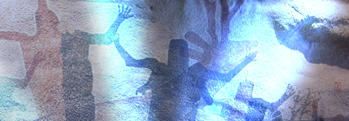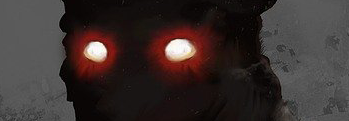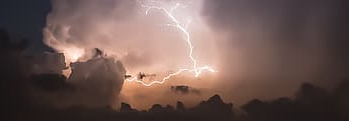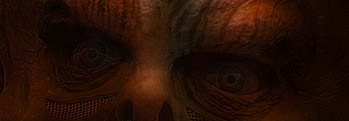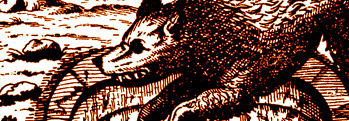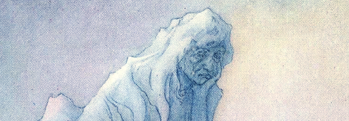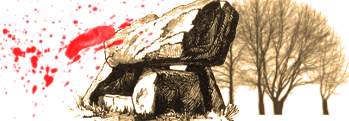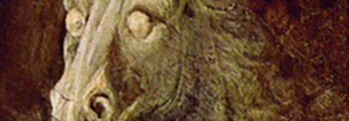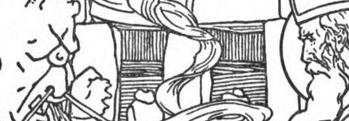The Fall of Crom Cruach
Irish and Celtic myths and legends, Irish folklore and Irish fairy tales from Irish Gods and Monsters
An ancient demon laid low - The Fall of Crom Cruach
Crom Cruach was one of the old gods of Ireland, one of the few mentioned as a god in the Annals of the Four Masters, an ancient Irish codex telling of the times before Christianity came to Ireland. His name may have many meanings, but he was most commonly known to the people as Crom Dubh, or the crouching darkness. His worshippers are said to have gathered at Mount Brandon in County Kerry and Croagh Patrick in Mayo, but nowhere is the name Crom still known as well as at Moy Slecht, where he was called Cenncroithí, meaning "the head of all gods".
A lonely and windy plain between Leitrim and Cavan, it first enters the tales of yore when King Tigernmas son of Follach, the first to smelt gold more than three thousand years ago, the first king to give drinking horns to his followers, and the first to have clothes dyed purple, blue and green and decorated with brooches, fringes and ornaments, built a circle there for the worship of old black stoop, the wizened bent one of many glooms.
 It is written that during his reign a vessel came from across the ocean from the king of the feared and sorcerous Fomors, demanding the wealth of Ireland, gems, tin and copper, and the means for their shaping. Tigernmas called to himself the chieftains of the land to take counsel about this demand but they said they'd rather keep the goods for themselves, and why not.
It is written that during his reign a vessel came from across the ocean from the king of the feared and sorcerous Fomors, demanding the wealth of Ireland, gems, tin and copper, and the means for their shaping. Tigernmas called to himself the chieftains of the land to take counsel about this demand but they said they'd rather keep the goods for themselves, and why not.
Well the Fomors took this none too kindly, so they sent Ishbaal, daughter of their king, who was married to Aodab, along with a cohort of their dark priests to Ireland. They brought with them an idol of gold and silver and stone, and twelve other dark deities covered in gleaming bronze. These priests of fearsome aspect bade Tigernmas to build a fortress on Moy Senaig, the plain of glorious deeds, as a temple for their gods, and Tigernmas agreed for the sake of peace.
The priests of Crom Cruach brought the idols to that place and demanded that the Gaels should be summoned to hear the judgements of these gods on their troubles. But when the people gathered they weren't inclined to bow before the stones, so the priests threatened them with vile curses and fell works of magic, saying their corn would wither and their cows would be dry unless they gave worship to the stones.
After the people bowed on their knees, the priests passed their judgement with awful smiles on their faces - Crom Cruach demanded the firstborn child of each family and each herd in sacrifice, their heads to be dashed upon Crom's idol, that the richness and wealth of the land might not be struck down!
Great was the weeping of the people of Ireland as they heard this, and they hurled themsleves against the rocks and jagged trees of the plain, breaking their noses and the joints of their knees and elbows. Three quarters of their number perished so on Samhain, including Tigernmas himself, slain by Crom for their defiance, but those that remained rose up against the power of the Fomorians, slaughtering their chief and as many of the rest as they could catch. The Fomors fled in great haste from Ireland then, returning to their own land.
The bards sang sad songs over the body of Tigernmas, who with ten hundred and three thousand of his people died in that place, in his seventy seventh year. Thereafter the plain was known as Moy Slecht, the plain of prostrations.
And yet the worship of the Bent One of the Hill persisted for centuries after, for he was not a power to cross lightly, nor were the Druids the sorts to turn up their noses at even so deadly a supernatural ally, and his servants walked the fair green earth of Ireland sowing fear where they went.
Then came the time of Patrick and the dawn of the Christian faith in Ireland, and Patrick, upon hearing of this pagan god, went forth with haste to Moy Slecht. There he raised his crosier and struck the mighty idol, breaking it open and banishing the sly darkness that oozed out from within back to the hell from whence it came! And the twelve surrounding stones sank deep into the earth, with only their tops protruding as witness to this great miracle.
Patrick led the survivors of this battle to a well close at hand and baptised them into the faith, building a church there as well. And yet even to this day, farmers and travellers stay well clear of Moy Slecht, whispering before the hearth that something yet stirs in the deep places of the earth. Some speak of a smell of burning meat, while others report faint chanting on the farthest winds at certain times of the year. Images of strange and shadowy forms in the area at sunset have been taken, and apparitions yet haunt the area, or so some say.
Indicated on the map below is the plain itself.
More Irish Gods and Monsters
It is during the darkest winter nights that we sit inside our houses and listen to the wind hammering at our windows and doors, as if it had a mind and will of its own – as if it wished to do us harm! The old people of Ireland believed that was the literal truth, that there were demons of the air, or demna aeóir thronging about the ... [more]
No tale of ancient Ireland could be complete without mentioning the Fomorians, dreaded foes of the Tuatha Dé Danann and all who came to conquer Ireland. The meaning of their name is debated even today, although most agree that the first part, fó, means “from below” or “nether” and the latter part means “t ... [more]
The dragons of Ireland were not like the dragons of other places, since they did not have wings or often even claws, and only rarely did they breathe fire, if at all! The were called the Ollphéisteanna, which means “great worms” or “mighty reptiles”, the terrible serpents of the world that was. The greatest among t ... [more]
It's well known that the people of Ireland are gifted in poetry, music, writing and the arts, and many have to come to these shores to admire these works. But there is one who moves through the misty glens and dappled glades of Ireland and it is the poets who whisper to her in the darkest hours of the night, hoping for an answer! This fairy ... [more]
In Ireland of old, the Alp-Luachra was one of the most dreaded of all the fairy folk. It also went by the name of Joint-eater, Just-halver, Art-Luachra, Airc-Luachra, and Doichi-Luachair. This creature made its abode in Irish streams and rivers and any place where green life grew from water. Outside of a person it was not much to look at, being ... [more]
Among all the fairy folk who wander the mists and glimmerings of Irish folklore, there are few as feared as the Fear Gorta, whose name means “the Hungry Man”. When hunger stalks the land, it does so as a hound following the footsteps of the Fear Gorta, a solitary, gaunt and masterless spirit of emaciated appearance. Now this fairy is ... [more]
One of the great terrors of ancient – and not so ancient! – Ireland was the Cú Sidhe, or the hound of the Sidhe. This monstrous beast was known in all of the lands once ruled by the Gael, being called the cù-sìth in Scotland and the Cŵn Annwn in Wales. They were also known as the Coinn Iotair, Hounds of Rage, whi ... [more]
A name which echoes through many ancient Irish myths and legends is that of the spirit of the oceans, Manannán mac Lir. Was he a Gaelic god and father of gods, a powerful king of old, first among the Tuatha De Danann, a title for a cult of secretive mystics or a Lord of the Otherworld? Perhaps all of these and more, or none. The earliest ... [more]
Across the northern parts of Ireland and Scotland people sometimes whisper of a terrifying spirit that can sometimes be seen before a big storm hits, the one they call the Storm Hag, or the Cailleach. She is known as the queen of winter, and her destructive power is most often witnessed at the end of winter, when her power is fading. The people ... [more]
Whispered across misty ages from times long gone are stories of the Cailleach, one of the ancient goddesses of the first people to walk in Ireland, queen of the mighty glaciers that once clenched the land in their frozen grip. Many tales are told of the old hag, but fewer speak of her consort, the Bodach! His name means “the old man” ... [more]
When Saint Patrick banished the serpents from Ireland, there was one who was overlooked, perhaps because he slumbered or was abroad himself, and that one was called Lig na Paiste, or the “Last Great Reptile”. Soon after Saint Patrick passed away, he made his presence known as he was known of old to the people of Owenreagh! A giant se ... [more]
Throughout the lands where Gaelic was spoken, the legend of the water horse was whispered by many a fireside, or sometimes told in a hurry by someone running the other direction! There are many lakes in Ireland, and most of them aren't very large, but they run still, dark and deep. The Each-Uisce, as the water horse or horse-eel was known in ... [more]
Of all the different kinds of goblins that haunted the lonely places of Ireland in days of old, air-demons were most dreaded by the people. They lived among clouds, and mists, and rocks, and they hated the human race with the utmost malignity. In those times lived in the north of Desmond (the present county of Cork) a man man named Fergus O'Mar ... [more]
In many cultures those that used to be called insane held a special place of reverence, and were treated almost as envoys from another place, or as though they could see something nobody else could, or were dancing to music only they could hear and the rest of us were deaf to. From far-off India and China to more familiar shores people would doff t ... [more]
Ancient Ireland was said by some to have been plagued by a particularly large and fierce breed of wolf, and men would sometimes go to war with them, or call them to war alongside heroes and champions! They would even make so bold as to attack villages and towns, and a great pack of them assailed Coleraine in the year 1650. To battle these fierce ... [more]
An Cailleach or the veiled woman is among the most ancient deities venerated in Ireland, she whose realm lies in the ice and cold of winter. Once it was said that she ruled all the world, when the green things slept for untold aeons beneath her thick icy cloak, until she was given cause for great sorrow and wept floods of tears across the land, her ... [more]
While most people nowadays believe fairies to be gentle creatures, prone to mischief perhaps and capricious by their natures yet well intended for all that, in Ireland they have a more sinister reputation. Some say, and some still believe, that the fairies will take small children and young people, leaving in their place creatures known as changeli ... [more]
They do say that good things come in small parcels, but often forget to add that not all small parcels are filled with good things! And so it was in the little village of Slaughtaverty in the distant past, ruled as it was by a fearsome dwarf-tyrant known as Abhartach. Stature and size were much prized in ancient Ireland, as well they might be fo ... [more]
In ancient times, even before the Tuatha De Dannan and the Fir Bolg went to war over the green land of Ireland, the land was ruled by a powerful sorcerous race called the Fomors. Warped and strange they were in appearance, some say dark of skin while others claim they dwelt at the bottom of deep lakes and in the turbulent depths of the ocean' ... [more]
The Pooka or Puca is one of the most ancient fairy creatures of Ireland, and is known further abroad as well, called Puck or Pook. In some places he is feared and in others respected. He can take many shapes, most commonly that of a wild horse wrapped in chains with sulfurous or blazing crimson eyes - the night mare - a huge dog, a raging bull, a h ... [more]
The Banshee or woman of the fairy folk as she is known in Ireland has many names, the Little Washerwoman, Hag of the Mist and the Hag of the Black Head. She takes three forms, that of a young and comely maiden, a matron of full and generous figure, or that of a wretched old crone, and is dressed in red or white or as the occasion calls for it, in t ... [more]
Crom Cruach was one of the old gods of Ireland, one of the few mentioned as a god in the Annals of the Four Masters, an ancient Irish codex telling of the times before Christianity came to Ireland. His name may have many meanings, but he was most commonly known to the people as Crom Dubh, or the crouching darkness. His worshippers are said to have ... [more]
Old Jack Doherty was a kindly and good natured sort of fellow, as well he might be for he had chosen to live in a strange and desolate part of the country, by a coast of jagged rocks and sucking tides. And why might that be cause for merriment, you may ask? Well, it was many's the night and many's the storm that blew an unfortunate ship too ... [more]
Of all the wonders and terrors in Irish folklore there are few quite so terrifying as the Sluagh. Tales were told of their wild hunt long before the coming of Christianity to Ireland, and even today old folk in the countryside will keep the windows on the west side of the house fastened tight at all times, but most especially during wakes or if som ... [more]
The Red Thirst, the Dearg Due, was these thousand years gone by a young maiden of surpassing fairness. Bards sang songs of her skin as fair as springtime snow and her lips as red as rubies in the light of the setting sun, men came from far and wide to seek her hand in marriage. And yet pretty as she was, he true beauty shone from within, as kindly ... [more]





